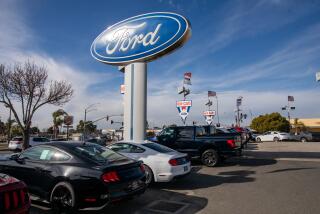Another Driving Route: Auto Leasing
- Share via
We all remember our first car.
It may have been a clunker that barely ran or a gleaming testament to teen-age ingenuity.
But it was ours.
Today, when people dream about new wheels they need to decide if they want to actually own the car.
Auto leasing, once available only to businesses or affluent consumers seeking luxury cars, has more than doubled in the last 10 years and now includes all types of vehicles and consumers in all income groups.
Statistics compiled by CNW Marketing Research, an Oregon auto research company, show that leases accounted for a record 23% of the 5.8 million new passenger cars American consumers drove home last year. CNW projects that leases will account for 24.3% of car acquisitions this year and almost 40% by 1998.
New car depreciation is one reason for leasing. “Do you really want to spend $20,000 so you can have an $8,000 car at the end? From an economic side, it makes no sense to put your money into a depreciating asset,” says Art Spinella of CNW.
But probably the primary reason for the increased popularity of leasing is affordability. The price of cars has risen beyond what many people want to spend and by leasing consumers can drive a more valuable car than they could afford to buy.
“People are trying to keep their automotive budget within certain guidelines,” says Spinella. “A second reason is that there are so many other disposable-income choices. The auto industry’s competitor isn’t necessarily another auto maker. It’s Chevy vs. Sony vs. mutual funds.”
The lure of leasing is a low monthly payment based on the difference between the price of the new vehicle and its expected value at the end of the lease. In other words, customers pay only for what they use.
Experts agree the cheapest way to keep a car is to buy it and run it as long as you can. But leasing might be a good option for consumers who drive fewer than 15,000 miles annually and trade in cars every three to four years.
There’s also convenience. Some people don’t like dealing with the maintenance woes of older vehicles. Others don’t like the hassle of selling a used car or negotiating a trade-in, says Bill McGuire, assistant editor of Consumer Reports, published by Consumers Union.
The obvious disadvantage to leasing is an empty driveway at the end of the contract.
Although most contracts let consumers buy the car at the end of the lease, most experts say the way to get the primary benefits of leasing is to turn the car in and lease a new one. That means never-ending car payments, a way of life that makes some people uncomfortable.
Negotiating a lease contract is not as straightforward as buying a car. Should you decide leasing is the way to go, there are some rules to follow and pitfalls to avoid:
* There are two types of lease agreements: closed-ended and open-ended. In the first, the consumer returns the vehicle at contract’s end and walks away. Except for specified charges such as excessive mileage or wear, the consumer is not responsible for the returned car’s value.
Consumers should avoid open-ended leases, in which the consumer is responsible if the car depreciates more than expected. If the returned car is worth less than specified in the contract--a value based on the dealer’s appraisal at the time of the deal--the consumer suffers the difference in an “end-of-lease payment.”
* Shop for a lease with as much determination as when buying a car. “You have to look at all the numbers in a lease, not just the monthly payment,” says McGuire of Consumer Reports.
He recommends getting at least three quotes on a lease. Talk the cost of the car down as low as possible, as you would when buying a car. And dicker on the lease rate; often manufacturers will write it down to almost nothing.
* One of the primary benefits of leasing is that the initial cash outlay is less than when buying. Although there are upfront costs--usually a security deposit, first and last periodic payments, sales taxes, title fees, license fees and insurance--the total should be much less than a down payment.
Don’t be lured into contracts that offer rock-bottom monthly payments. Those terms are only available with a a hefty upfront charge.
* If a leased car is stolen or destroyed, the lease is terminated early. Standard auto insurance covers the vehicle’s market value, but everything else--the remaining payments or a termination fee--is your responsibility.
So-called “gap insurance” makes up the difference; some dealers charge for it, others don’t. “It’s a good idea to have but only for a low-to-nothing cost,” McGuire says.
* Watch for contract terms that could cost you at the end of the lease. Many contracts are vague about what is considered excessive wear and tear and “you could be handed a bill for several thousand dollars,” McGuire says. The lease should be specific.
Some dealers also require consumers to pay a disposition charge--the cost of preparing the vehicle for sale.
Other costs include mileage fees, end-of-lease payments and default penalties.
* Remember, the dealer has no obligation to sell you the car at the end of the lease unless the contract has a purchase option. Depending on the residual value of the car--its worth at the end of the lease if you turn it in--you might want to consider buying it and selling it yourself.






